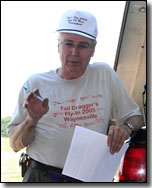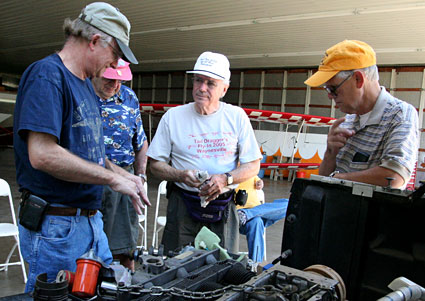EAA Chapter 284 talks Corvair engines
Posted By RichC on July 8, 2007
 Our EAA Chapter 284 was fortunate to have Gary Collins present his experiences in converting a Corvair engine for experimental aircraft use. Many aviation conversions have been done before, as they have with air cooled Volkswagen engines, but Gary’s personal notes and observation made for an exceptional source of information. He provide us with and enjoyable overview into both the mechanics of the conversion, the resources he used and a realistic cost breakdown (he est. $4000 with some scrounging). His personal notes (included below) were very helpfully and the hands on with a variety of parts he brought along a real treat. Thanks Gary, I look forward to visiting your shop.
Our EAA Chapter 284 was fortunate to have Gary Collins present his experiences in converting a Corvair engine for experimental aircraft use. Many aviation conversions have been done before, as they have with air cooled Volkswagen engines, but Gary’s personal notes and observation made for an exceptional source of information. He provide us with and enjoyable overview into both the mechanics of the conversion, the resources he used and a realistic cost breakdown (he est. $4000 with some scrounging). His personal notes (included below) were very helpfully and the hands on with a variety of parts he brought along a real treat. Thanks Gary, I look forward to visiting your shop.
THE CORVAIR AIRCRAFT ENGINE Gary B. Collins, EAA Chapter 174
Notes from William Wynne www.flycorvair.com Most recent stuff is at the “At The Hangar” heading
Need:
– Wynne conversion manual from WilliamWynne ($59)
– 1965 GM Corvair Chassis Manual ST-59 (about $25)
– How to keep your Corvair Alive by Richard Finch (about $20)
These and other parts and services you will need may be obtained from a Corvair parts warehouse:
Clark’s Corvairs
400 Mohawk Trail Rt. 2
Shelburn Falls, MS 01370
413-625-9776
The Corvair Underground
502-434-1648
Larry’s Corvair Parts
310-970-9851
Identifying engines – You want 164 cid (2700 cc), 110 hp 1965-69. With codes on case RD,RF,RH,RX,RK Engines from junkyards go from nothing to maybe $200.
You do not want the earlier smaller cid or dual carb or turbo engine. (A crank from a turbo engine would be OK as GM nitrided them) See Wynne for identifying all the engines.
CONVERSION MEANS Cleaning, Inspecting, and modifying-as little as possible.
Crankshaft modified to – mount the prop, strengthen Safety shaft ($76)
hybrid studs ($76)
Hub ($479) New and worth it.
Deep Nitriding (about $250)
Forged PistonsCamshaft replaced with OT-10 from Clark’s. More lift, shifts torque peak to lower rpm.
Distributor — Buy from Wynne. ($239) It is modified and has two sets of points set 180 degrees apart and advance set to go from 8- 32 degrees. Engine will run on either system. Uses two coils and can switch between systems. Vacuum advance removed.Use standard aircraft carb Marvell-Schebler MA3-SPA, Stromberg NAS-3, or Aerocarb. Intake to dual ports is ugly but the long pipes not a problem on the engine for aircraft use. If you were wanting fast acceleration as on a dragster they would not be good but at the RPM we are using and the relatively smooth, slow throttle movement in aircraft use, they work well.
Bell Housing becomes the front of the engine. Cut out with Saber saw or band saw. Will take 30 minutes to cut out and smooth the edges.
Blower housing removed and is replaced with at flat plate. ($49)
Use Ford Taurus ring gear ($99) and Subaru starter($209), John Deere garden tractor 20 amp dynamo.(about $200)
Have standard valve job from loc?1 shop or have heads modified by Wynne recommended shop.
New deep oil pan. ($269) New hydraulic lifters are about $2.50 apiece.
Standard Exhaust System works well and is cheap. Straight stacks will work. Custom made system will get you about 4% more power and weigh less-but cost more in time and money.
Wynne sells a complete engine ready to install for $7995.00 See his web site for details. I think you can build up your own for at least $3-4,000 less than that. It depends on how much you are willing to do or get done locally at little or no cost.
If you can build an airplane you can convert a Corvair engine. You will learn a lot about engines. If the object is to have the lowest possible risk then you should buy a Lycoming or a Continental. I decided that in a light sport plane with a low wing loading and thus a low landing speed, I could tolerate the risk. When I started working on mine Wynne was comfortable with a much less complex conversion. But to his credit, as he gains experience he is willing to change what he recommends. An example is the recommendation to have all crankshafts deep nitrided. That decision was made after he pulled several engines out of service for very careful magnaflux inspection after several crankshaft failures. Most showed cracks beginning in as little as 50 hours. Some of them were using prop extensions which he has always said should not be used. One did not show any sign of cracks and it was one of the cranks from a 180 hp turbo Corvair which GM had nitrided in the old fashioned way. The new deep nitriding process should toughen the cranks even more. Both Rotax and Jabraru engines have had crankshaft failures in the last 3 years so this problem is not only a problem for the Corvair.
With a Covair you will have a cool sounding 100+ horsepower, very smooth engine. It will not have fully redundant systems and will not be exactly equivalent to a certified engine. With all accessories it will weigh about 225 pounds which is the installed weight of an 0-200 Cont. Testing by Wynne has shown the 0-200 to put out about 85 hp while on the same test rig, the Corvair will put out an honest 100 hp. Any plane that has flown on the 0-200 will fly well with the Corvair. It will cruise at 28-2900 rpm at low altitude and 3200 rpm up high. Some of the 3 100 cc Corvairs are pulling KR-2s and the Sonex around at 170 mph and 3600 rpm but those planes would perform just fine with a 2700 cc Corvair at perhaps half the cost.

Comments